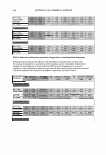414 JOURNAL OF COSMETIC SCIENCE INORGANIC SUNSCREEN DISPERSIONS: EXPERIENCE WITH DEVELOPMENT AND EVALUATION FOR EFFICACY AND AESTHETICS Art Georgalas1, Elizabeth Kasprzyk1, and Andreas Jung2, Ph.D. 1 TRI-K Industries, Inc, New Paradigm Technologies, Northvale, NJ 2 /FAC GmbH, Duisburg, Germany Formulators must take into consideration multiple factors working with inorganic sunscreens. Because the UV radiation attenuation grade particles of Titanium Dioxide are in the nanometer range, the state of their dispersion in the product film on the skin governs their efficacy and aesthetics.Properties of the particles themselves, including size and coating, the media they are dispersed in and the efficiency and stability of those dispersions impact their performance on the skin. In the final formulation even the same dispersion can give different results depending on the formulation and process. Agglomeration state of particles on the skin film gives variable ratios of UVR and visible light absorption resulting in differences in transparency and sun protection efficacy. Inorganic particles interact with light both optically as inert reflectors and diffractors and as electromagnetic absorbers. They must be effectively dispersed in the finished product and delivered to the skin in a continuous film to work well. An iterative process of experiments using particle size analysis, rheology and suspension properties evaluation to optimize them formulates dispersions. Finally, by looking at in vitro instrumental measurements, in vivo clinical results for efficacy, product draw down films and skin application a full picture of performance emerges.The chronic effects of long-term UVR exposure display as visible signs of aging and increased incidence of some skin cancers. A reproducible bioassay to give immediate assessment of UVR attenuation can only be made with effects that are acute or instrumental methods that simply measure the light flux effects. Acceptable in vivo methods inc1ude sun protection factors (SPF) for UVB radiation generated erythema and the measurement of the effects on persistent pigment darkening (PPD) compared to untreated skin for UVA radiation. In vitro broad-spectrum capability is demonstrated by identification of the critical wavelength of subject product. This is the wavelength at which the area under the absorbance curve beginning at 290 nm up to that wavelength is 90% of the total solar UV radiation absorbed as measured instrumentally from 290- 400 nm, so that, the higher that wavelength the more absorption occurs within the UV A range (320- 400 nm). Additionally, instrumental measurement can estimate a UV A protective factor and a ratio of UV A to DVB attenuation. These are measures accepted or being considered by dermatologists, industry formulators and regulatory agencies worldwide. Premade dispersions of the UVR attenuation pigments make formulation easier but also improve efficacy and aesthetics in some formulations, so that these were under evaluation. Preliminary results with some dispersions indicate more UVB versus UV A attenuation with smaller particles and as less and less agglomerates form. This drives the critical wavelength lower but these formulations still show significant UV A effect along with good sunscreen efficacy by SPF measures. Different grades of titanium dioxide were chosen to represent a full range of varieties available. These included ultra small particle, 10 nm &15 nm, hydrophobically and hydrophilically coated particles, microtitanium dioxide, 35 nm particle size, both uncoated and 20 & 21 nm hydrophilic and hydrophobically coated particles and a larger pigmentary grade of 180 nm plus a new ultra large (1 micron) particle designed to attenuate IR radiation. A variety of Zinc Oxides were also
2004 ANNUAL SCIENTIFIC SEMINAR 415 tested. To test variability in different types of formulas, both two oil-in-water creams and a water in-oil silicone formulation were evaluated. Tests performed in vitro were via the Optometries 290 SPF Analyzer utilizing IMS Vitro Skin TM as substrate to better mimic skin application. Clinical studies performed at AMA labs used FDA protocol for SPF and JCIA protocol for PPD assessment of UV A protection. Overall the experiments demonstrated that Titanium Dioxide and Zinc Oxide had advantages when preformulated into dispersions depending also on particular varieties and formulations. When the critical wavelength is compared to the ultimate particle size there appears to be a relationship that graphically suggests that critical wavelength will always be above 370 nm. However, some dispersions in which particles are better dispersed and agglomerates are minimal yield critical wavelengths below 370 nm. Materials and Methods: Sunscreen formulations were prepared with the following general compositions that were altered individually to accommodate the different grades of Titanium dioxide used: 10 nm Aluminum Stearate Hydrophobic 15 nm Aluminum Stearate coated Hydrophobic20nm Alumina Glycerin Hydrophilic 21nm Trimethoxycaprylylsilane Hydrophobic 35 nm uncoated Hydrophilic Pigmentary grade 180 nm Rutile Hydrophilic One micron (1,000nm) silicone coated Hydrophobic Formula A. Oil-in-Water Emulsion Formulation nonionic/anionic •Water •Magnesium Aluminum Silicate •Glycerin • Xanthan Gum •Butylene Glycol •Phenoxyethanol/Parabens •Glyceryl Stearate and PEG-100 Stearate •Brassica Campestris / Aleurites Fordii Oil Copolymer •Sorbitan Sesquioleate •DEA-Cetyl Phosphate •C12-15 Alkyl Benzoate •Octyl Palmitate •Cetyl Alcohol •Titanium Dioxide (+Coatings) 5.0-10.0% Formula B. Oil-in-Water Emulsion Formulation liquid crystal gel network •Purified water •Glyceryl stearate, Cetearyl Alcohol, Stearoyl Lactylate •Glycerin •Dimethicone •Caprylyl Methicone •Brassica Campestris / Aleurites Fordi Oil Copolymer •Decyl Shea Butter Esters •Polysorbate 20 •Phenoxyethanol/Parabens • Xanthan Gum •Titanium Dioxide (+Coatings) 5.0-10.0%
Purchased for the exclusive use of nofirst nolast (unknown) From: SCC Media Library & Resource Center (library.scconline.org)






































































































